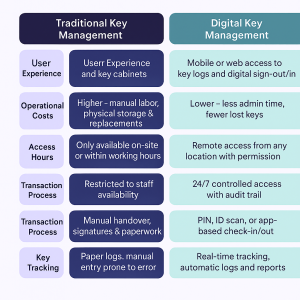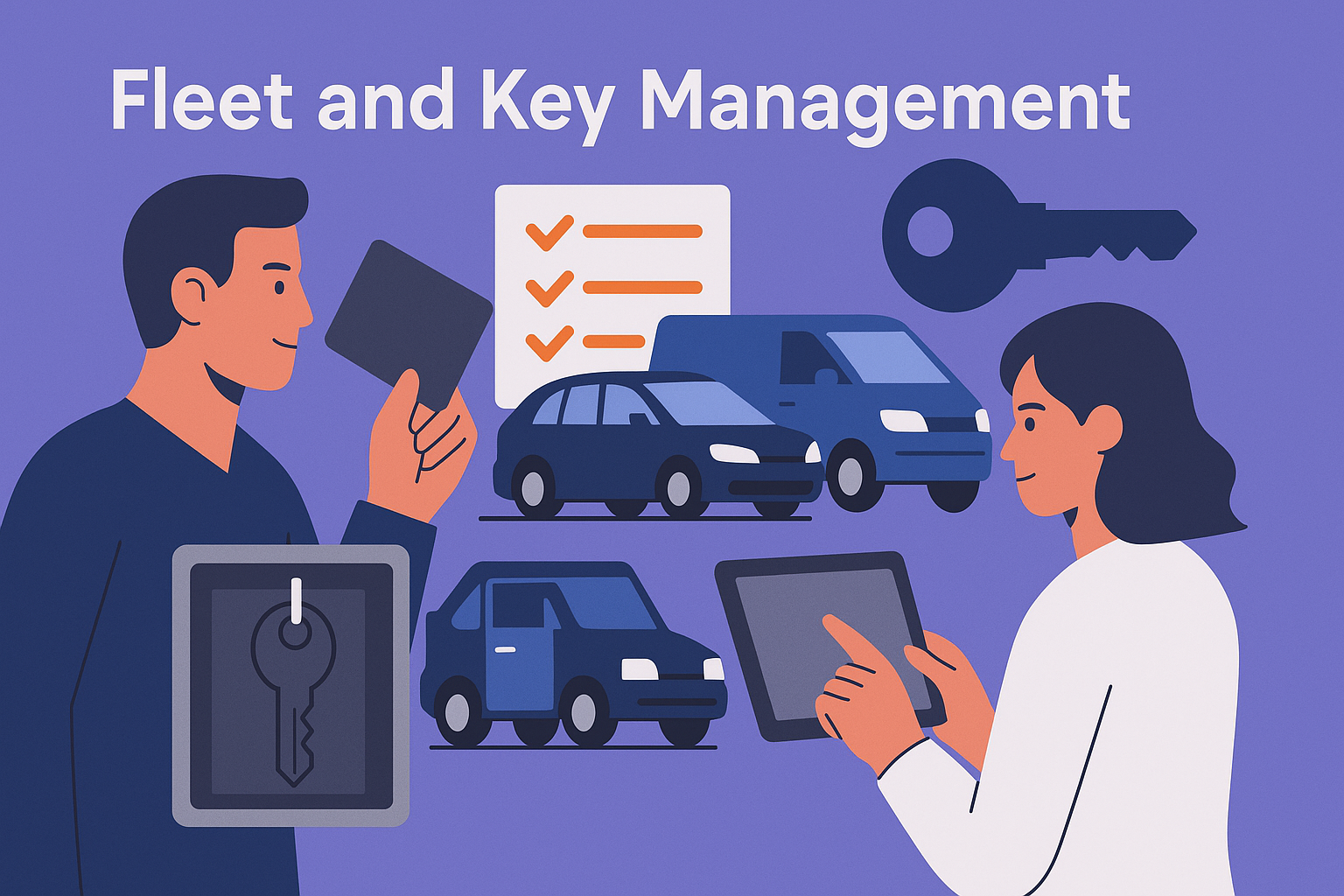In the modern fleet management industry, companies are navigating a complex landscape where traditional key control meets advanced digital solutions. The crucial question of traditional vs. digital fleet key management systems remains a critical decision for fleet managers and commercial vehicle operations.
Today, in this comprehensive guide, we will bridge the divide by exploring both approaches’ key differences, advantages, and disadvantages.
Table of Contents
What is Traditional Fleet Key Management?
Traditional fleet key management refers to the manual handling and tracking of vehicle keys in commercial fleets through physical key cabinets, manual logbooks, and paper-based processes. It involves direct human oversight and tangible key control methods for fleet operations.
Here are some main characteristics of Traditional Fleet Key Management:
- Physical Key Cabinets:Requires physical key storage cabinets and manual logging systems, creating tangible fleet key control for vehicle management.
- Manual Oversight:Allows direct human oversight of key handoffs between fleet managers and drivers, fostering driver accountability.
- Limited Geographical Reach:Customers are restricted to the store’s location, limiting the potential market size.
- Fixed Operational Hours:Bound by opening and closing times, potentially hindering customer convenience.
Advantages of Traditional Fleet Key Management
- Personal Fleet Accountability:Allows for direct interaction and building accountability between fleet managers and drivers.
- Immediate Vehicle Access:Drivers can access fleet vehicle keys immediately when needed for scheduled routes and deliveries.
- Physical Security:Physical key control systems provide visible security measures for fleet vehicle management.
Disadvantages of Traditional Fleet Key Management
- High Administrative Costs:Manual fleet key tracking, lost key replacement, and dedicated staff time can be significant financial burdens for fleet operations.
- Limited Fleet Visibility:Manual tracking systems restrict real-time vehicle key location visibility and driver accountability.
- Operational Inefficiencies:Manual processes can lead to lost fleet keys, vehicle delays, and poor fleet access control.
What is Digital Fleet Key Management?
Digital fleet key management refers to tracking and controlling vehicle keys in commercial fleets through electronic systems and smart technology. It leverages QR codes, RFID tags, and mobile applications to streamline fleet key control processes and vehicle access management.
Some key characteristics of Digital Fleet Key Management:
- Digital Fleet Tracking:Operates through mobile applications and cloud-based systems, providing real-time vehicle key location data for fleet managers from anywhere with an internet connection.
- Multi-Location Support:The ability to manage fleet keys across multiple depots and vehicle locations, significantly expanding fleet operational control.
- 24/7 Fleet Monitoring:Provides continuous key tracking, allowing fleet managers to monitor vehicle access around the clock.
- Automated Fleet Workflows:Utilises QR codes and RFID technology to streamline fleet key handoffs, reduce administrative costs, and increase vehicle operational efficiency.
Advantages of Digital Fleet Key Management
- Enhanced Fleet Visibility:Can track keys across multiple fleet locations and vehicles, boosting operational control and driver accountability.
- Cost-Effective:Lower administrative costs than manual systems, reducing lost fleet key replacement expenses and fleet management staff time.
- Fleet Accessibility:Enables fleet drivers to access key information anytime, anywhere, improving fleet operational efficiency.
- Fleet Audit Trail:Provides valuable fleet key tracking data and detailed logs for accountability, compliance reporting, and fleet management analysis.
Disadvantages of Digital Fleet Key Management
- Technology Dependencies:Reliance on internet connectivity and device functionality requires backup systems and technical support for fleet operations.
- Initial Setup Costs:Implementation of digital systems requires upfront investment in hardware, software, and fleet staff training.
- Learning Curve:Fleet staff adaptation to new digital processes may initially slow vehicle operations until full system adoption.
Traditional vs. Digital Fleet Key Management

Future Trends in Fleet Management Key Control
The future of fleet management key control is likely to be a hybrid model that merges the strengths of both traditional and digital approaches. Here are some emerging trends in commercial fleet key management:
- Smart Fleet Key Tags:Advanced RFID and Bluetooth-enabled key tags offer real-time location tracking and automated alerts for enhanced fleet vehicle security and driver accountability.
- Multi-Depot Integration:Seamlessly connecting key management across multiple fleet depots and locations provides unified vehicle access control for commercial fleet operations.
- AI and Fleet Automation:Digital fleet key management systems will leverage artificial intelligence for predictive analytics and automated key distribution for vehicle scheduling.
- Augmented Reality (AR):AR will allow fleet managers to quickly locate keys through augmented reality interfaces, enhancing operational efficiency for vehicle fleet management. According to fleet management industry reports, the global market for commercial fleet key management systems is expected to grow significantly as companies modernize their vehicle operations.
- Blockchain Technology: According to fleet management technology experts, blockchain technology offers significant potential for fleet key management systems, enhancing security and creating tamper-proof audit trails for vehicle access control in commercial fleet operations.
FAQ on the Difference between Traditional and Digital Fleet Key Management
What is the difference between traditional and digital fleet key management?
The difference between traditional and digital fleet key management lies in their tracking methods. Traditional fleet key management involves manual processes using physical key cabinets and logbooks, while digital fleet key management utilizes QR codes, RFID tags, and mobile applications for automated vehicle access control.
Can a fleet operation integrate both traditional and digital key management?
Yes, fleet operations can integrate both approaches to leverage their strengths. This hybrid strategy can enhance operational efficiency while maintaining physical security measures for vehicle access.
Conclusion
Both traditional and digital fleet key management systems have their unique strengths and challenges. While traditional fleet key management offers physical security and direct oversight, digital systems provide real-time tracking, automated workflows, and comprehensive audit trails. Fleet operations must evaluate their operational needs and resources to determine the most suitable approach or consider integrating both to maximize their efficiency.
By understanding these differences and implementing effective fleet key management strategies, commercial fleet operations can improve operational efficiency and enhance vehicle security. Whether you choose the reliability of traditional key control or the advanced capabilities of digital systems, the key lies in ensuring proper vehicle access control and driver accountability.


